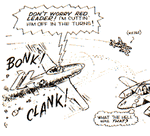Civettone
Tech Sergeant
I disagree. Aren't most fighter vs fighter engagements fought at close range? Isn't it more important to have a high MV when engaging enemy bombers so you can hit the target while staying away from their defensive guns?The armament bares the entire blaim, the low muzzle velocity of the rounds meant the Mk108 wasn't suited for fighter vs fighter combat
Kris

